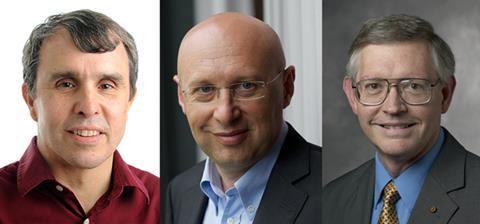This year’s Nobel prize in chemistry is a classic tale of beating impossible odds and the laws of physics
Rather than some biologists being woken up by a call from Stockholm to discover they are chemists, as the old joke goes, this year it was two physicists and a physical chemist. And there was a new Nobel joke on the day of the announcement, from committee member Sven Lidin. As he started his presentation, he asked if somebody could improve the resolution. But he wasn’t having technical issues with a projector – improving the resolution with which scientists can zoom in on the microscopic had scooped this year’s prize.

The newly minted laureates are W E Moerner, Stefan Hell and Eric Betzig and the prize was awarded ‘for the development of super-resolved fluorescence microscopy’. You can read our feature-length take on the prize on p44 and Mark Peplow’s thoughts on p39.
The interdisciplinary nature of the prize is immediately clear: a physical technique, developed with help from chemistry, that helps illuminate problems in biology. It’s hard to think of a Nobel prize that better sums up the interconnected nature of modern cutting-edge science. While labels can be useful – for departments and job titles, for example – they should not become barriers. And it is true almost to the point of clichõ that the most interesting and ground-breaking work is done when scientists apply their talents in new fields.
Another facet of this award that means it will live long in the memory is that super-resolved microscopy broke what seemed to be an immutable wall in the laws of physics: Abbe’s diffraction limit. Briefly stated, German physicist Ernst Abbe discovered in 1873 that it is impossible to resolve features smaller than half the wavelength of the light you’re using, with a lower limit of around 200nm. And as far as most scientists were concerned, that was that. But by the mid-1990s, a few people were starting to use clever techniques to give them a work-around.
Moerner’s breakthrough was to be able to detect the light given off by a single fluorescent molecule. Betzig took the principle further, building up layers of images of differently coloured fluorescent molecules to create a single high-resolution image. Hell used two laser beams, one to quench all the fluorescence around a much smaller nanosized area being excited by the second. Scanning the sample and patching together each nanosized area gives a composite picture, again beyond the best resolution predicted by Abbe.
No great story is complete without a rags-to-riches narrative arc, and yet again the Nobel committee has found one for us. Betzig fell out of love with science soon after publishing the theoretical basis for his technique and went to work for his father’s machine company (admittedly as vice-president of R&D). He built the first photoactivated localised microscope in his friend’s living room.
Hell also went through a tough time developing his technique, working long days to slowly prove his theory would work before running out of funding. And when he got the stimulated emission depletion microscope to work, both Nature and Science rejected his work.
So in a nutshell, this is the Nobel prize for everyone to enjoy: chemists who can look at single molecules, physicists who can yearn to break a law themselves one day and biologists who can investigate the inner mechanics of living things in unprecedented detail. And if you’re not a scientist, perhaps you can still appreciate the story of great progress made against the odds, through painstaking work and intuitive leaps.












No comments yet